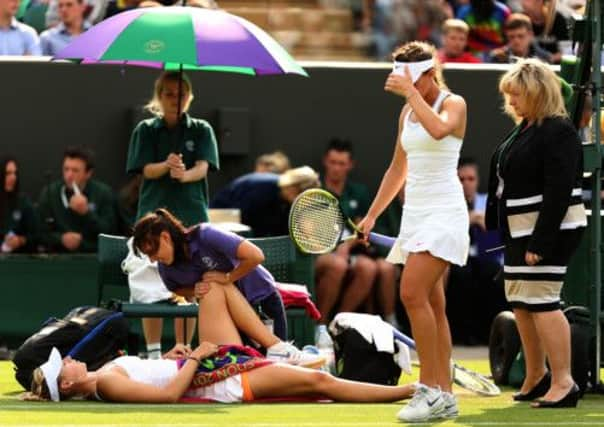If you fail to prepare then prepare to fail – and slip up – at Wimbledon


A rueful Rafael Nadal was soon on his way home to Majorca nursing his dodgy knees after a first-round pounding by the unsung Belgian Steve Darcis.
Then it was goodbye to the men’s titleholder Roger Federer whose elegant game was destroyed by the serve-and-volley ebullience of Sergiy Stakhovsky from Ukraine.
Advertisement
Hide AdAdvertisement
Hide AdNeither of the unexpected conquerors lasted another round – the injured Darcis withdrew without hitting another ball – but their victories made an indelible impact on the men’s singles.
Then it was the courts which grabbed the headlines.
The message from some players was that the All England Club’s hallowed turf was more like a skidpan.
Maria Sharapova, who fell three times in losing to Michelle Larcher De Brito, described the court as dangerous.
Seven players pulled out because of injury in an unprecedented exodus which included a dismayed Jo-Wilfried Tsonga ,who normally brings bonhomie to any tournament.
Advertisement
Hide AdAdvertisement
Hide AdThe inquest rumbles on. Was it something to do with the texture of the grass this year, or the way the courts had been cut? The general feeling is that a lack of competitive preparation on the surface is a key factor.
Slipping and sliding on grass is an acquired skill and it is up to the players to adapt. In other words, don’t knock the grass, which has never looked better than it does this year.
Yorkshire’s interest in the singles was extinguished in the first round, but the defeats of Kyle Edmund and Tara Moore were full of encouragement for the future. Edmund, 18, from Beverley, did nothing to tarnish his image as a young player to watch as he went down in straight sets to Poland’s impressive Jerzy Janowiczs, who moved on to a fourth-round clash with Jurgen Meltzer.
The result should not be allowed to overshadow Edmund’s outstanding promise.
Advertisement
Hide AdAdvertisement
Hide AdSimilarly there was much to admire in the performance of Moore, 20, whose Yorkshire base is Doncaster. She was beaten 5-7 7-5 5-7 by Kaia Kanepi , the Estonian who meets Laura Robson in the fourth round.
Sturdy, stubborn and mobile, Moore has the mental and physical attributes to make headway in the women’s game.
Robson, of course, is now firmly established as Britain’s new tennis heroine, after a heart- warming display against New Zealand’s Marina Erakovic in which she came back from a set and 5-3 down to win 1-6 7-5 6-3.
The match showed the worst and the best of Robson, from wandering concentration and sloppy serving to the incisive striking of the ball which made her a deserving victor. She should succeed where Tara failed.
Advertisement
Hide AdAdvertisement
Hide AdWhich leads us to Andy Murray, who has yet to concede a set in the tournament and looks increasingly like the next champion, particularly in view of the departure of Federer and Nadal from his half of the draw.
But let’s not get too excited, yet. There is a long way to go before Murray has the chance to achieve his dearest ambition. And Novak Djokovic is looking ominously relaxed.